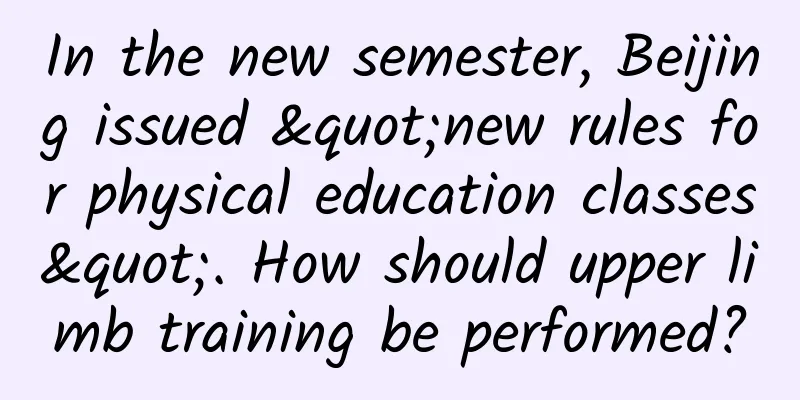In the new semester, Beijing issued "new rules for physical education classes". How should upper limb training be performed?

|
Recently, the “Eight Rules for Physical Education” for primary and secondary schools jointly issued by Beijing Municipal Education Commission and Sports Bureau have attracted widespread attention. Among them, in response to the weak items in the physical fitness test, the Beijing Municipal Education Commission will implement a weak point strengthening action to strengthen students' upper limb strength. Starting from the fourth grade of elementary school, Beijing will gradually increase the students' horizontal bar hanging support and inclined pull-up projects to scientifically support students' upper limb strength improvement, while alleviating students' scoliosis and round shoulders . These measures will be fully implemented in the new semester . Individual schools that are not equipped with high and low horizontal bars are required to be equipped before the end of the year. In addition, based on the actual situation of Beijing students, exercise standards for different grades are formulated : Test items and compliance standards (Source: Beijing News) Selection of sports field test items for the 2025 Beijing Junior High School Academic Level Examination (sample picture) In addition, in the selection of physical education on-site examination items for the Beijing Junior High School Academic Level Examination in 2025, the pull-ups and dips in the "Quality Item II" (there are six items in Quality Item II, you can choose one), also focus on testing students' upper limb muscle strength. This further highlights the key position of upper limb muscle strength in the physical development of adolescents during their growth stage. From the single bar hanging support and inclined pull-ups that are the focus of daily physical exercise in schools to the key examination items of the junior high school academic level examination, they all revolve around strengthening upper limb muscle strength, which is enough to show its importance to the development of adolescent physical fitness. Many parents and students are full of doubts: What is the “secret weapon” value of upper limb training? What other precautions should you be aware of? Don't worry, our reporter interviewed Li Liang, associate researcher at the National Physique and Scientific Fitness Research Center of the National Sports General Administration Research Institute, and Xu Baolu, national team sports nutritionist at the Institute of Sports Medicine of the National Sports General Administration, to reveal the answers to you one by one. What role do movements such as horizontal bar hang support and incline pull-ups play in upper limb strength training for teenagers? Li Liang: These two movements are really "good helpers" for teenagers to train their upper limb strength. Let's talk about the horizontal bar hang support first. This movement is relatively simple and can be mastered quickly by primary school students. It only requires a horizontal bar, which is basically available in schools, so it is very convenient. The horizontal bar hang support mainly relies on the upper limbs and core muscles to maintain the static posture of the body, which can enhance static strength and endurance. Inclined pull-ups are even more powerful. Not only can they increase upper limb strength, but they can also effectively exercise the back and shoulder muscles. They also require the coordination of upper and lower limbs for a more comprehensive exercise. Horizontal bar hanging support (picture from the Internet) Inclined pull-ups (Photo from the Internet) From the perspective of sports physiology, the horizontal bar hanging support mainly relies on isometric muscle contraction to maintain posture. During exercise, the upper limb muscles must maintain the stability of the shoulder and elbow joints, and the core muscles must also exert force to keep the trunk stable. Inclined pull-ups are different. They require muscles to complete dynamic concentric-eccentric contractions, which can improve the concentric contraction strength and explosive power of the muscles. In addition to the upper limbs and core muscles, the back muscles are also activated. The combination of these two training methods is like a "muscle synergistic development package" that can better improve muscle strength, endurance, stability and coordination. How to balance strength development and joint protection in view of the spinal health and posture correction needs of primary school students? Li Liang: For spinal health and posture correction, the exercise load must be adjusted during training. We have to make targeted adjustments based on the student's gender, age, basic physical condition, etc. The principle is to proceed step by step, and the intensity cannot be increased all at once. For example, students with less strength can use elastic bands to support themselves during training to reduce the load of their own weight. You can start with a short time of hanging support on the horizontal bar, such as 10-15 seconds, and slowly increase the time. For inclined pull-ups, first lower the body's inclination angle or reduce the range of motion, and then do standard movements after the body has adapted. When exercising, you must pay attention to tightening the shoulder joints and keeping the spine in a neutral position, so as to maintain body stability. Primary school students' bones and muscles are still developing and cannot withstand excessive load and incorrect training. Several aspects need to be taken into consideration. First, teach them the correct exercise movements. Second, beginners can reduce the load by adjusting the movement pattern or using auxiliary equipment (elastic bands). Third, there should be enough recovery time after training, and they should not train too frequently or too much. Fourth, they should warm up well before each training, especially to activate the upper limb muscles. What are the most common mistakes or safety hazards that students make when they first start horizontal bar training? Li Liang: When students first start to train on the horizontal bar, they tend to make a lot of mistakes. For example, if the bar grip is incorrect or irregular, some students may not have enough strength or irregular movements, so they will hold the bar backwards, or their palms will not completely cover the horizontal bar, and the distance between their arms will be either too wide or too narrow. There are also shrugging and incorrect hanging postures. Students may unconsciously shrug their shoulders, which may put too much force on their shoulders, or their arms may be too straight, making their bodies unstable. Unstable core control is also a common problem. Beginners often ignore their core muscles, causing their bodies to swing left and right, which can easily lead to loss of balance and increase the risk of falling or straining. In addition, the head posture is incorrect or unstable, the head shakes during hanging or inclined pull-ups, and the body leans back or forward too much, which not only affects the coordination of movements, but may also increase the pressure on the cervical spine. There are also situations where the equipment is not prepared in a standardized or comprehensive manner, and the height of the horizontal bar is not appropriate, which can easily cause problems when students perform movements. But don't worry, these problems can be solved. The coach must guide students to master the correct grip of the bar, use the straight grip method, with arms as wide as shoulders or slightly wider than shoulders, and palms completely grasping the horizontal bar. It is important to emphasize maintaining a natural hanging posture and avoid shrugging shoulders. Demonstration can help students adjust their posture to ensure that their shoulders are relaxed and their elbows are slightly bent. It is also necessary to strengthen core strength training so that students can stabilize their bodies during horizontal bar training. Do core warm-ups before training to strengthen the abdominal and waist strength. Remind students to keep their heads in a neutral position and look forward. If they can't hold on during training, they can't force themselves to exert force, and they need to rest and adjust in time. The school must also be powerful, equip horizontal bars of different heights or adjustable heights, and choose a horizontal bar of appropriate height for training according to the height and ability of students. Soft pads or protective pads should be set around the horizontal bar. The coach should always pay attention to the status of the students and provide timely protection to avoid sports injuries. Is it necessary to introduce recovery methods such as dynamic stretching and fascia relaxation? Li Liang: This is very necessary. A complete training program must include warm-up activities before training and relaxation activities after training. Dynamic stretching is the main warm-up activity before training, which is to gradually increase the stretchability and flexibility of muscles by stretching the joints and muscle groups. Before the horizontal bar hanging support and inclined pull-up training, targeted activation of shoulder, arm and back muscles, improvement of upper limb flexibility, and increase of shoulder and elbow range of motion can reduce the risk of injury during exercise. To relax after training, you need to use static stretching to relax tense muscles. After training, muscles are still in a tense and contracted state, and the circulatory and respiratory systems are also maintained at a high level. Doing some effective stretching activities can reduce the excitability of nerve-muscle coupling, gradually relax tense muscles, and slowly restore the body's systems to a calm state. How can parents help students relieve muscle fatigue after exercise through daily diet? Are there any dietary habits that need to be avoided? Xu Baolu: Parents can help relieve muscle fatigue after exercise by ensuring that their children have a balanced diet. They should ensure that their children consume staple foods, vegetables and fruits (the two cannot be replaced), and protein foods, while avoiding excessive intake of fat foods. In addition, children can be given simple snacks before and after training, such as fruits, yogurt, bread with eggs or lean meat buns, etc. (avoid excessive fat), which will help restore muscle glycogen and relieve muscle fatigue. Because sports fatigue is divided into neural fatigue and muscle fatigue, most of the fatigue in adolescent training is muscle fatigue, which requires energy supplementation. Muscle contraction consumes carbohydrates and glucose, namely muscle glycogen. Intake of staple foods before and after training can provide energy for exercise, replenish muscle glycogen, and thus relieve fatigue. What differentiated adjustments should be made to training intensity and nutrition plans for students who are malnourished or overweight? Xu Baolu: For students with malnutrition (low weight) and overweight, the training intensity and nutrition plan need to be adjusted differently. Overweight students put great pressure on the hip, knee and ankle joints. As long as the horizontal bar training is gradual and the load is not too large, it will generally not cause too much pressure on the joints. From a kinematic point of view, it is necessary to distinguish between training intensity and capacity. Both should be gradual and rest should be arranged reasonably. Adolescents have strong recovery ability. If they have symptoms of overtraining, such as joint pain, injuries, depression, and persistent muscle soreness, it may be a normal phenomenon that the body is stimulated because they have not trained before, or it may be that they have exercise experience but the training volume is too large. It is necessary to increase the rest adjustment period and adopt periodized training, such as gradually increasing the intensity for 3 weeks, and reducing the intensity in the fourth week to let the body recover. This is the general logic. Students who are underweight should pay attention to recovery after training, because their energy intake is continuously low, and they need to increase energy intake to allow muscle synthesis and generate more strength to increase the strength required for horizontal bar movements. Students who are overweight need to reduce their weight first and avoid training that puts too much pressure on the joints, such as fast sprinting and jumping, because the ground reaction force during these exercises will cause too much pressure on the joints. The reaction force is about 3 times gravity during jogging and may reach 5 times gravity during fast sprinting. The heavier the weight, the greater the reaction force. What advice do you have for schools regarding sports nutrition? Xu Baolu: From a professional perspective, it is recommended that schools add sports nutrition science courses. Sports are a process of exerting stimulation, and nutrition is a process of helping recovery. Reasonable stimulation plus reasonable recovery can make the body stronger. Students first accept knowledge, generate trust and belief, and ultimately influence behavior and make healthy choices. Therefore, both students and athletes need nutrition science education. When physical education classes are no longer limited to running and jumping, and when nutrition knowledge is integrated into campus life, children will gain much more than test scores. Perhaps one day in the future, they will find that the sweat they shed in the stadium has twisted their spines and made them tough. Giving growth strength and health direction - this may be the real Easter egg buried by the "Eight Articles on Physical Education". Written by: Reporter Duan David Interview experts: Li Liang Associate Researcher at the National Physical Fitness and Scientific Fitness Research Center of the National Sports General Administration Research Institute Xu Baolu, Sports Nutritionist of the National Team, Institute of Sports Medicine, General Administration of Sport of China Editor: David Duan |
<<: “A Bite of China 4” reveals: When food meets physics, it’s amazing!
Recommend
Li Jiaoshou·Top Copywriter's 5th Anniversary Sharing Speech
The theme of this speech is: X-type copywriting a...
Popular Science Online | All diseases in the world are caused by our immune system losing the battle
Modern people believe in chemical drugs and think...
Stock Market Shilin April Practical Training Camp
Resources of Guhai Shilin April Practical Trainin...
User operation examples, creating a lost user recall system
The author will share with you his exploration an...
YouTube to launch monthly ad-free membership, but TV stations not support it
YouTube is the world's largest original video...
Using the gravity of a planet to fling a probe out? The magic of the "gravitational slingshot"
In the setting of "The Wandering Earth"...
Bidding promotion: 6 secrets to high conversion!
A few days ago, someone chatted with me and said:...
Before traveling into space, why not learn some vegetable-growing skills?
CCTV News: From entering the Chinese space statio...
With the first flight of a low-sounding aircraft imminent, is supersonic travel just around the corner?
The X-59 is a unique experimental aircraft. It is...
Do animals grieve when their companions die?
In 2000, Karen McComb and others placed an elepha...
Case Analysis|Review of Himalaya FM's "66 Membership Day" event
1. Activity Background 1. Market conditions Pay a...
Three steps to teach you how to improve personal and team competitiveness!
In the past, human resources, especially human re...
Can ginger, Polygonum multiflorum and black sesame really help grow dark hair?
Every time I look in the mirror and find a few ne...
How to increase Internet users!
When it comes to user growth , most people will t...
Meizu 16s Pro review: We see Huang Zhang's sincerity in creating an artistic flagship phone
Only four months after the release of Meizu's...









